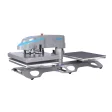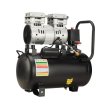Types of Heat Press Machines

Types of Heat Press Machines
There are several types of heat press machines, each designed for different applications, materials, and production needs. Here’s a breakdown of the most common types:
1. Clamshell Heat Press
Best for: Beginners, small businesses, T-shirts, and flat items.
- Design: The upper heating plate folds down like a clamshell.
- Pros:
- Compact and affordable.
- Easy to use (one-handed operation).
- Cons:
- Limited space for thick items (like hoodies with zippers).
- Less even pressure compared to swing-away models.
2. Swing-Away Heat Press
Best for: Professional use, thicker materials (towels, bags, hats).
- Design: The heating plate swings out completely, allowing full access to the lower platen.
- Pros:
- Better pressure distribution.
- Accommodates bulkier items (e.g., padded jackets).
- Cons:
- More expensive than clamshell.
- Takes up more space.
3. Drawer-Style Heat Press
Best for: High-volume production, sublimation on flat items (like mouse pads).
- Design: The lower platen slides out like a drawer for easy placement.
- Pros:
- Great for precise alignment (good for multi-color transfers).
- Consistent pressure.
- Cons:
- Not ideal for thick fabrics.
- Less common than clamshell/swing-away.
4. Multi-Purpose (Hybrid) Heat Press
Best for: Versatility (can press shirts, mugs, caps, plates, etc.).
- Design: Comes with interchangeable attachments:
- Flat platen (for shirts).
- Mug press (for coffee mugs).
- Cap press (for hats).
- Plate press (for ceramics).
- Pros:
- Saves money (one machine does multiple jobs).
- Cons:
- Attachments may not be as efficient as dedicated machines.
5. Automatic (Digital) Heat Press
Best for: Large-scale businesses, consistent results.
- Design: Uses pneumatic pressure and digital controls for precision.
- Pros:
- Fully automated (consistent pressure & timing).
- High efficiency for bulk orders.
- Cons:
- Expensive.
- Requires more maintenance.
6. Manual (Lever-Based) Heat Press
Best for: Budget users, occasional projects.
- Design: Uses a manual lever to apply pressure.
- Pros:
- Cheaper than digital models.
- Cons:
- Less consistent pressure.
- Requires more effort.
7. 3D Vacuum Heat Press
Best for: All-over prints (AOP), sublimation on curved objects.
- Design: Uses a vacuum to wrap heat around 3D items (like shoes, phone cases).
- Pros:
- Great for complex shapes.
- Cons:
- Expensive.
- Limited to sublimation.
Which One Should You Choose?
- Beginners/Hobbyists: Clamshell or swing-away.
- Small Businesses: Swing-away or multi-purpose.
- High-Volume Production: Automatic or drawer-style.
- Sublimation on Mugs/Hats: Multi-purpose or dedicated mug press.
Would you like recommendations based on your specific needs?
.







